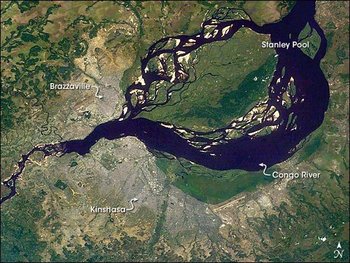Kinshasa
|
|
Kinshasa (formerly Léopoldville) is the capital and largest city of the Democratic Republic of the Congo. With a population of about 4.5 million, it is also one of the largest cities in sub-Saharan Africa.
| Contents |
Geography
Kinshasa is a city of sharp contrasts, with posh residential and commercial areas, two universities, and sprawling slums coexisting side by side.
It is located along the southern bank of the Congo River, directly opposite the city of Brazzaville, capital of the Republic of the Congo. Kinshasa is located at 4°16' South, 15°17' East (-4.2667, 15.28333).
Major areas of the city include the Cité de l'OUA, home to the Government of the Democratic Republic of Congo, Zone de Matonge, known internationally for its nightlife, and the residential area of Gombe. The city has a major river port at Beach Ngobila with ferries to Brazzaville and Bangui, a railway to Matadi and N'Djili Airport.
Notable features of the city include the SOZACOM Building and Hotel Memling skyscrapers, the central market, the Kinshasa Museum and the Kinshasa Fine Arts Academy. The Boulevard du 30 Juin links the areas of the city together.
History
The city was founded as a trading post by Henry Morton Stanley in 1881 and named Léopoldville in honor of King Léopold II of Belgium, who ruled the vast territory that is now the Democratic Republic of the Congo. The post flourished as the first navigable port along the Congo River above Livingstone Falls: at first, all goods arriving at Léopoldville from the interior would have to be carried by porter to the port of Matadi along the coast. The completion of a railroad in 1898 provided a viable means of transportation along the river's lower reaches and sparked the rapid development of Léopoldville. By 1920, the city was elevated to capital of the Belgian Congo, replacing the seaside town of Boma.
In 1965 Mobutu Sese Seko seized power in the Congo in his second coup and initiated a policy of "Africanizing" the names of people and places in the country. In 1966 Léopoldville was renamed Kinshasa for a village that once stood near the site. The city grew rapidly under Mobutu, drawing people from across the country who came in search of their fortunes or to escape ethnic strife elsewhere. This inevitably brought about a change to the city's ethnic and linguistic composition as well. Although it is situated in territory that traditionally belongs to the Bakongo people, the lingua franca in Kinshasa today is not Kikongo but Lingala.
Kinshasa suffered greatly due to Mobutu's excesses, mass corruption, nepotism and the civil war that led to his downfall. Nevertheless, it is still a major cultural and intellectual center (by Central African standards), with a flourishing community of musicians and artists. It is also the country's major industrial center, processing many of the natural products brought from the interior. The city has recently had to fend off rioting soldiers who were protesting the government's inability to pay them.
Media
Kinshasa is home to a large number of radio and TV stations. The National TV is housed in the city. Its 2 channels reach more or less the entire country. In additional to these stations, there are nearly a dozen terrestrial stations reaching the environs of the city, and sometimes a bit beyond.
External links
- Rumble In The Jungle - Muhammad Ali Kinshasa, 1974 (http://www.boxing-memorabilia.com/aliforeman2.htm)
See also
Template:Democratic Republic of the Congode:Kinshasa es:Kinshasa fr:Kinshasa he:קינשאסה nl:Kinshasa ja:キンシャサ no:Kinshasa os:Киншасæ pl:Kinszasa pt:Kinshasa ru:Киншаса fi:Kinshasa sv:Kinshasa



